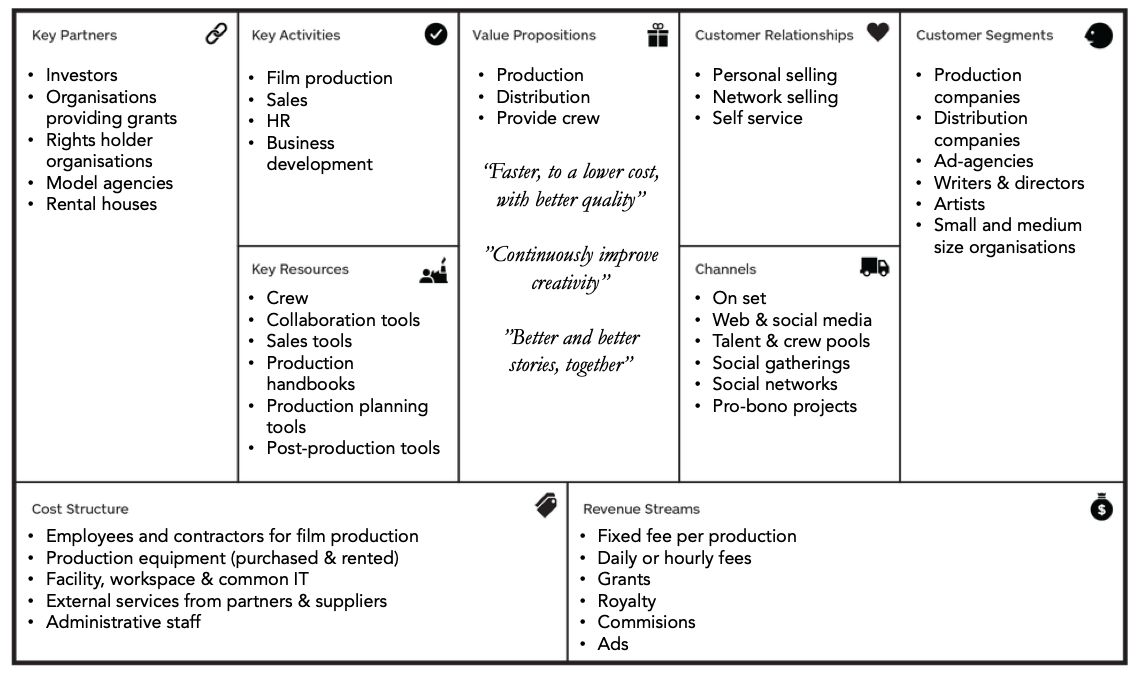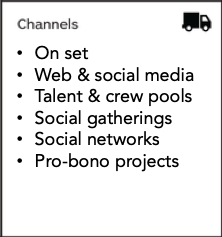EA case study - Business Model Canvas
A business model canvas is not a static document, it’s something that evolves over time. The first full canvas for Artmann Media was done during fall 2018. Based on our experiences since then, it’s now updated for 2020 and beyond.
We describe what we include in each part of the canvas and some of our reasoning behind from a business perspective.
Some details are deliberately omitted in this post, other things are probably things we missed and could improve to next version.
The work is based on the method from the book Business Model Generation by Alexander Osterwalder & Yves Pigneur.
Value Proposition
We like film, storytelling and team work. This is why we focus on the Value propositions in the Business model canvas.
The main driver for our work is ”Better and better stories, together” and this gives us Production of Film, Video and TV as Value proposition. The benefit for the customers are “Faster, to a lower cost and with better quality”.
We add Distribution of Film, Video and TV as a Value proposition to make it possible to show others what we create. Distribution is limited to the case we are the producer as we don’t want to compete with distribution companies as a customer segment.
We think the market in the Nordics is to small to have a sustainable business for a new company with only Production & Distribution for film, video and TV. This is why we add Provide crew to Film, Video and TV productions as a value proposition.
As most production companies don’t have their own crew, we see this as a possible business, even if we are competing with them in doing other productions.
The same crew can work in different productions and have a high utilisation rate. Actors are more limited to specific roles, and this is the main reason why we don’t want to have a model agency as a Value proposition.
Equipment ties up capital and could differ very much between types of production. This is why we avoid to be a rental house and use them as Key Partners instead.
By a coincidence, all three value propositions have standard codes when doing a company registration.
Customer segments
Customer segments are the main type of customers groups for our Value propositions.
Production companies is the main Customer Segment of crew for film productions. They could also buy a part of a production from us were we are responsible for a team, using our tools.
Distribution companies are the buyer, but also financiers of film productions.
Ad-agencies need crew to commercials and are therefore a customer segment for the business.
Writers & directors is a customer segment for both film production and to provide crew to their productions.
Artists are another group of customers that we can provide production and distribution for.
Small and medium size organisations are clients for corporate and event productions and distribution.
Each Customer segment buys slightly different variants of the Value propositions and our markering and sales process must reflect this behaviour. To be more detailed in later posts.
Channels
The film business is very much based on personal relationship and references in an relativity small community. The Channels we choose to work reflects this reality.
The channels are only defined on a high level. We have are not yet defined in detail and this, together with Customer Relationships are the areas were we need to improve in order to grow and be profitable.
We are also aware och the fact that different types of film, video and TV-productions needs different types of channels.
The channels needed for small and medium size organisations is either included in the Channels and Customer Relationships so far.
Customer Relationships
Customer Relationship is how we sell different types of Value propositions, to Customer segments via the different Channels.
Personal selling is done by dedicated sales persons or staff with high experience of selling both projects and resources towards targeted customers.
Network selling is when employees and contractors find the need for crew in productions, at different channels, or opportunities that is managed by personal selling.
Self-service is only for booking of crew in film productions, but is important as this is a lower margin part of the business.
Key Activities
The main processes that we have to be really good at are the Key Activities below.
Film production is delivery of our Value propositions and the most important process for the business as we want to provide “Better and better stories, together”.
Sales is important to get a high utilisation of crew and be profitable.
HR as our crew is our most important Key Resource.
Business development is key activity, as we have ”Continuously improve creativity” as our north star.
Key Resources
Key resources are the most important resources we need to have in order to deliver or value propositions. There are other resources needed, but these below are those we focus on.
Our key resource is our crew and to make better and better stories together, we need good collaboration tools. The production handbooks helps the crew to do repetitive work in the best way together.
We need good sales tools in order to manage a high number of proposals from clients, supporting self-service, personal sales and network sales.
In order to deliver productions, we need production handbooks where we include project management to manage risks. We also need good production planning tools in pre-production and production so we can work efficiently on set.
Finally, we need post-production tools that let us edit all types of productions in a fast and smooth workflow, even if we are located in different cities.
Key Partners
The Key Partners are those we need to have a close co-operation with, as we have made the decision not have these Key Resources ourselfs, but it’s needed by us to conduct our business and provide the Value streams
Moviemaking us expensive. This is why we need key partners as Investors for financing our film productions and Organisations providing grants
Everything we do is some type of copyrighted work. This is why we have to work closed to Rights holder organisations to have al legal parts in order, but also to manage Royalty that is a revenue stream.
We need talent for narratives and commercial film productions. This is why we need model agencies as key partners.
We need different types of equipment for all categories of film production. From e.g. cameras, sound, grip and lightning to set dressing, props and wardrobe in the scenes.
This is done on a regular basis for most types of productions and therefore we need partnership with rental houses and other suppliers of equipment and services during film production.
Revenue streams
The revenue streams describes how we earn money from film production, distribution and crew.
Fixed fee per production is main revenue stream for some types of productions, both small and large ones. It involves high risks and this is why we need production handbooks and production planning tools. For large projects where the risk is high do we need Investors to share both revenue and risk.
Daily or hourly fees is used when we Provide crew and is fairly simple model with lower risk, but with lower margin as well.
Grants are often necessary when producing documentaries and narrative productions. The rules depends on country and type of production and this is we need Key Partners in this area
Royalties, commissions and ads are all revenue streams that comes from the distribution part of the business.
Cost structure
Cost structure is rather simple, but we need to manage it to be profitable.
The main cost is staff, i.e. employees and contractors used in film production. But it doesn’t mean than we can forget the other types of cost associated with running the business as Production equipment etc.









